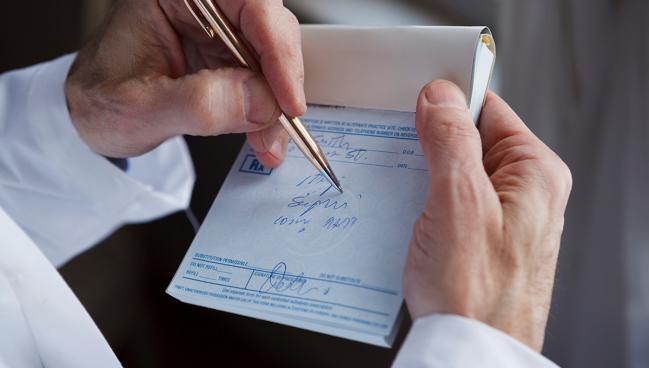Too Few Veterans Get Intensified Lipid-Lowering Therapy After Coronary Events
Several experts blame “clinical inertia” for the lack of treatment intensification. Digital tools and new ways of thinking may help.

In the year following MI or coronary revascularization, less than half of US veterans receive lipid-lowering treatment (LLT) intensification, according to new data from the Veterans Affairs (VA) health system. The researchers say this represents a “missed opportunity” for secondary prevention efforts.
Other studies have shown gaps between who should receive more intense LLT after an event and who actually does, with the largest discrepancies observed between the sexes.
As for why this might broadly be, lead author Alexander R. Zheutlin, MD (University of Utah School of Medicine, Salt Lake City), said “cognitive bias” likely plays a role.
“Did they just get started on multiple drugs and we’re hesitant to give them another medication or uptitrate a medication? Is there sort of doubt in terms of how well statins reduce further risk?” he suggested. “Other patient-related factors certainly could be at play.”
Zheutlin pointed out that patients who saw cardiologists over the course of the study had an increased likelihood of LLT intensification. “And so what it may be is that they had a lipid test and they just didn't have their clinical follow-up,” he said. “That really speaks to the workflow and patient-journey flow that needs to occur after an event, in which there needs to be appropriate monitoring, which we saw, but then appropriate touch points with the system or with clinicians who can provide guidance and intensification or initiation of appropriate therapy.”
Similarly, Fatima Rodriguez, MD (Stanford University School of Medicine, Palo Alto, CA), who was not involved with the study, told TCTMD in an email that “clinical inertia seems to be an important contributor to the study's alarming findings. Since the veterans in the study were plugged into regular sources of healthcare and had insurance covered by the VA (and most had follow-up visits during the year after their MI/revascularization), I suspect the care gaps would be even more pronounced across broader patient groups.”
LLT Intensification Lacking
For the study, published online last week in Circulation: Cardiovascular Quality and Outcomes, Zheutlin and colleagues included all 77,367 veterans (mean age 69 years; 2.3% female) hospitalized for an MI or elective coronary revascularization (81,372 events) at a VA facility between July 2015 and December 2019. Mean LDL cholesterol at baseline was 89.6 mg/dL, with 33.8% of the population reporting levels over 70 mg/dL. At the time of their event, 39.7% were not taking any LLT and 22.0% were taking a low-moderate intensity statin, 37.2% a high-intensity statin, and 0.6% ezetimibe.
LLT intensification occurred in 33.3% of veterans within 14 days, 41.9% within 3 months, and 47.3% within 12 months posthospitalization. LLT intensification was most likely to occur among the patients taking no LLT (82.5%) before their MI or coronary revascularization. For those on low-moderate, high-intensity statins, or ezetimibe at baseline, LTT intensification occurred in 60.3%, 2.5%, and 57.0%, respectively.
Other factors associated with a greater likelihood of LLT intensification included higher baseline LDL cholesterol, having a lipid test, and attending a cardiology visit. Those older than 75 and younger than 65 years were less likely to have LLT intensification within 12 months.
The researchers did not note any differences in LLT intensification patterns by sex.
Zheutlin said he was surprised to find that only about two-thirds of patients on low-moderate statins were intensified over 12 months. “[This] means they're not on a high-dose statin, which is the guideline recommendation,” he said. “And these are folks who tolerate the statin.”
Additionally, “the other part that was really surprising me is that folks who were on a high intensity statin at baseline, very few of those patients were intensified,” Zheutlin said. “That means [there’s] really low use of nonstatin-based lipid-lowering therapies such as ezetimibe or a PCSK9 inhibitor.”
Lastly, while “a really high percentage” received a lipid test within 12 months after hospitalization, still around two-thirds of them had an LDL-cholesterol level above 70 mg/dL and only 40% of that group were intensified, he observed. “The same goes of the 25% of veterans who had an LDL-C above 100—only 40% of those folks were intensified. So that means that these are people who have connections to the system. It's not like they were just lost to follow-up. They had monitoring and they were still not intensified, so that really stood out to me.”
Rodriguez also said it was “noteworthy” that lipid testing and visits with cardiology increased likelihood of LLT intensification. “This suggests that care pathways that involve patient navigators or pharmacists may help bridge treatment gaps in patients following MI or coronary revascularization,” she said. “I would like to see those types of interventions tested rigorously with pragmatic randomized clinical trials. A one-size-fits all approach is not likely to work for all patient groups with an indication for LLT.”
Future studies should also focus on the “huge gaps in adherence” of LLT, Rodriguez added.
Potential Solutions
In an accompanying editorial, Khurram Nasir, MD (Houston Methodist Hospital, TX), and Joseph A. Salami, MD (Florida Atlantic University, Boca Raton), call some of the results “alarming.”
It’s possible that “patient-related issues, such as side effects and nonpreferences, contribute to these lower rates of LLT intensification,” they write. But because the study showed that things like lipid testing and cardiologist visits resulted in higher LLT intensification, this suggests “underlying physicians’ therapeutic inertia, despite widespread availability, low cost for most options, [and] the overwhelming data supporting their benefits.”
The findings “should make us question if we have genuinely reached a plateau in our efforts to implement evidence-based approaches,” Nasir and Salami say. “Have we lost the flexibility required to quickly adapt to new evidence?”
Several solutions exist, but the editorialists recommend doubling down on two approaches. The first, they say, would be leveraging digital solutions to provide care teams with real-time information.
Zheutlin, speaking with TCTMD, gave the example of implementation studies comparing standard of care with electronic health record-based models that automatically intensify LLT based on lipid test results. Additionally, he suggested, preclinical messaging with patients that brings up LLT and associated goals before they see the physician might improve “patient buy-in.”
The second approach worth revisiting would be some of the “well established adages in our healthcare improvement community,” the editorialists suggest, such as public reporting and attaching a provider’s fee to LLT prescriptions—in other words, “the carrot or stick needed to improve the prescription of these critical interventions at discharge.”
To avoid the tunnel vision that can result with these tactics, Nasir and Salami recommend more stakeholder input on the design of the programs, on the kinds of outcomes sought, and on the payment models entailed.
Yael L. Maxwell is Senior Medical Journalist for TCTMD and Section Editor of TCTMD's Fellows Forum. She served as the inaugural…
Read Full BioSources
Zheutlin AR, Derington CG, Herrick JS, et al. Lipid-lowering therapy use and intensification among United States veterans following myocardial infarction or coronary revascularization between 2015 and 2019. Circ Cardiovasc Qual Outcomes. 2022;15:e008861.
Nasir K, Salami JA. Therapeutic inertia in lipid-lowering treatment intensification: digital tools and performance management to the rescue. Circ Cardiovasc Qual Outcomes. 2022;15:e009399.
Disclosures
- Zheutlin and Salami report no relevant conflicts of interest.
- Nasir reports serving on the advisory board for Nova Nordisk, Novartis, and Esperion and on the speaker’s bureau for Amgen.
- Rodriguez reports consulting for Novartis, AstraZeneca, HealthPals, and NovoNordisk (CEC).





Comments